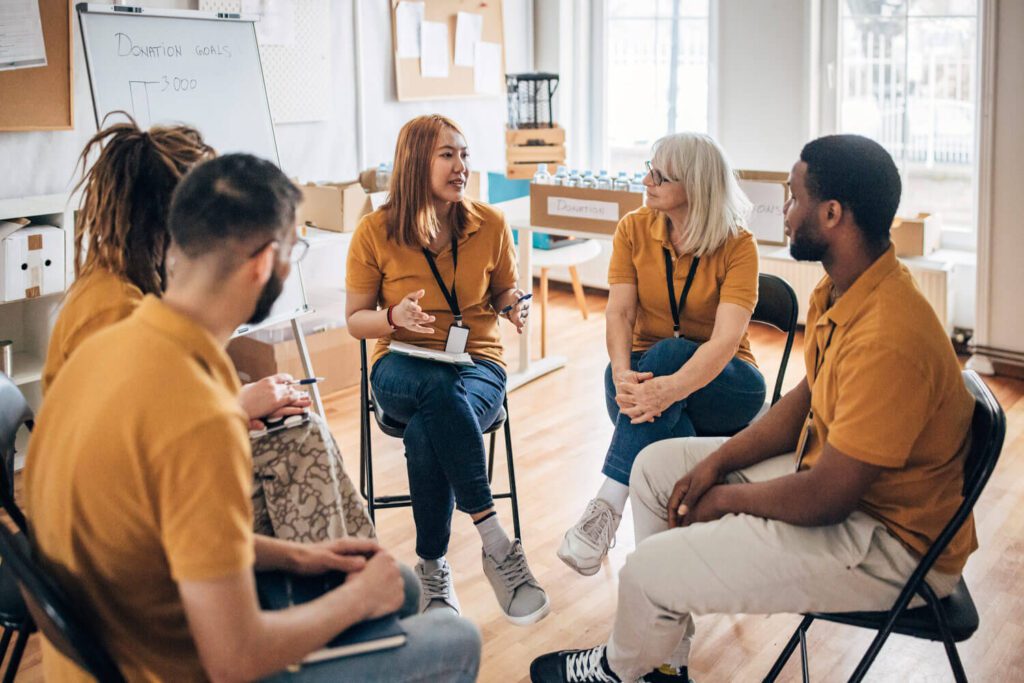Major gifts: The complete guide to securing large donations

Major gifts are essential to fundraising success, but many nonprofit organizations struggle to identify potential major donors and solicit the large gifts that are necessary for advancing their purpose.
If your organization is in this position, you’re not alone. Major gift fundraising comes with many challenges, but you can overcome them with the right tools, strategies, and support. In this guide, we’ll walk through the basics of major gifts, common questions, and tips for developing a successful major gift fundraising strategy for your nonprofit.
What are major gifts?
Major gifts are the largest individual donations an organization receives in a given year. As a vital resource for nonprofits of all sizes and in all verticals, these donations often provide the bulk of funding for the projects and programs that impact your community.
Because of their importance, soliciting major gifts requires more strategic attention than other fundraising processes. Major donor fundraising encompasses donor research, cultivation, solicitation, and long-term stewardship efforts to retain your most influential donors.
Why are major gifts important?
It’s estimated that about 80% of nonprofits’ individual donation revenue comes from the top 20% of donors. While the exact percentages fluctuate, the principle remains constant — major gifts fund the majority of your nonprofit’s work and are essential for furthering your purpose.
Additionally, major gifts are important for:
- Growing your organization’s network of supporters.
- Successfully completing capital campaigns and major projects.
- Maintaining a steady, predictable stream of annual income.
- Increasing your nonprofit’s capacity for growth over time.
An effective major gifts strategy helps organizations not only survive but thrive. By giving major gift fundraising the attention it deserves, you can strengthen your nonprofit’s fundraising campaigns, donor base, and long-term potential to drive impact.
Exploring the major gifts fundraising cycle
As mentioned earlier, major gift fundraising involves more than just asking for large donations. To effectively acquire and retain major donors, you must progress through each stage of the donor cultivation or major gifts fundraising cycle:
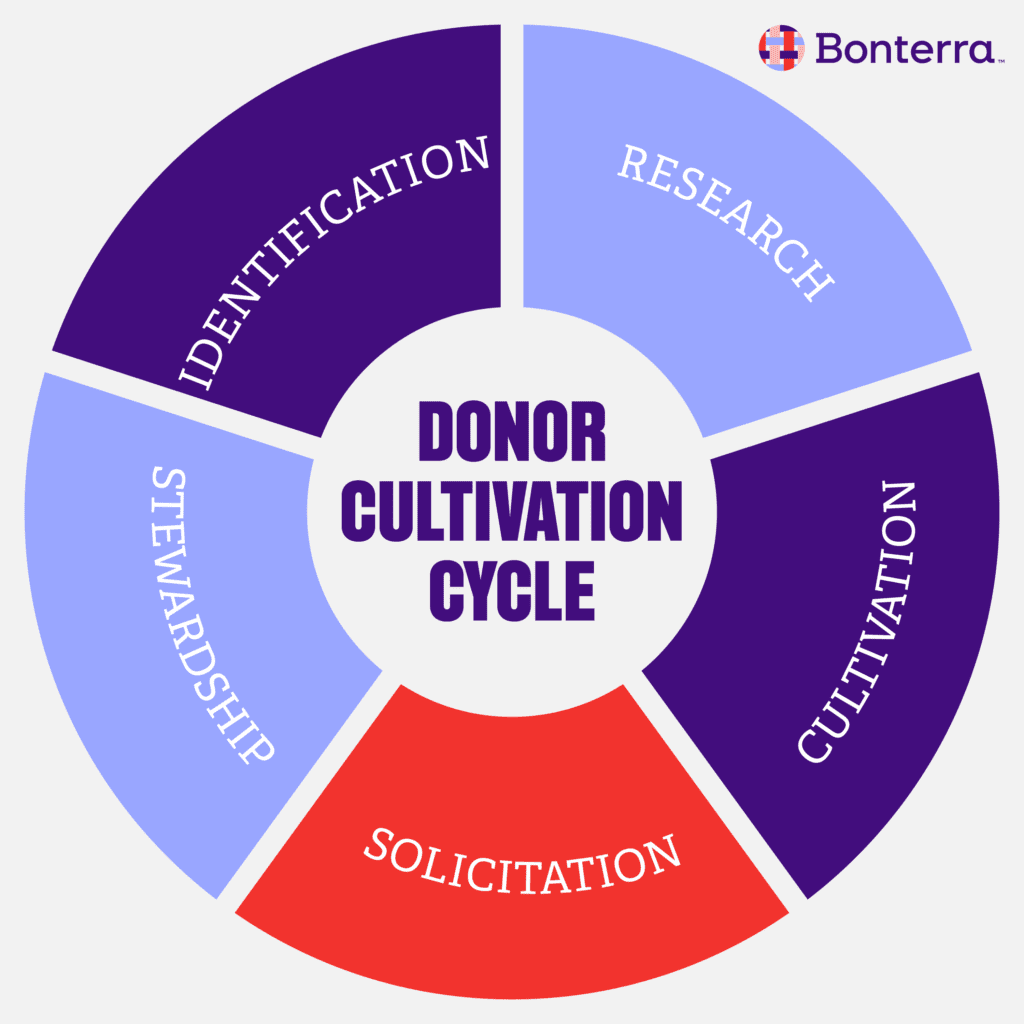
Identification and research
During the identification and research phases, your nonprofit conducts prospect research to find, validate, and prioritize major donor prospects. You’ll search your donor database for supporters with specific markers (such as employment and giving history) that indicate they may be able to make a major contribution, then use external sources like wealth databases and public donation records to supplement that data. Eventually, you’ll compile a list of promising prospects to start cultivating.
Cultivation
Even if your major donor prospects have supported your nonprofit for years, you shouldn’t ask them for a major gift out of nowhere. Instead, spend several months cultivating your prospect first — get to know their philanthropic priorities and how you can help advance them through one-on-one meetings, events, and other engagement opportunities. At the same time, help them learn more about your nonprofit’s upcoming projects and how they might support them.
Solicitation
Once you determine that a prospect might be ready to give, you’ll make your formal fundraising ask. Unlike standard appeals, successful major gift solicitations should always be done in person when possible. Prepare for the conversation by creating a basic script and choosing an appropriate ask amount for that particular prospect. Invite them to support a specific program or campaign that resonates with their values, and be prepared for all possible responses (we’ll discuss this more later).
Stewardship
If your prospect says yes and contributes a major gift, enter the donor stewardship phase and work to retain that relationship. This should start with multiple personalized appreciation efforts, such as thanking them publicly on a donor wall or inviting them to a celebratory dinner with board members. Major donor stewardship also involves demonstrating the gift’s impact, providing frequent updates on your work, and inviting the donor to get more involved.
Steps to create a major gifts strategy for your nonprofit
Now that you understand the basics of major gifts, let’s review how to create an effective major gifts strategy for your organization.
1. Set your major gift threshold.
There’s no standard amount that constitutes a major gift — the definition of a major gift varies from one organization to the next. For example, a nonprofit that is just starting out might count anything over $1,000 as a major gift, whereas a larger, well-established organization might only consider donations of more than $10,000.
To set an appropriate major gift threshold for your own nonprofit, review the fundraising data in your nonprofit’s constituent relationship management (CRM) system and follow these steps:
- Examine the donation amount range of 10 to 25 of the largest gifts your organization has received.
- Eliminate any outliers. If every gift is between $7,000 and $11,000, except for one at $25,000, eliminate the $25,000 gift from your list.
- Estimate a major gift minimum, accounting for the remaining gifts. Using the numbers from the previous step’s example, you might say $8,500.
- Go back to your database and test that number — $8,500 in our scenario. Determine how many donors made gifts of that amount or greater to your organization in the past year.
- Find the major gift sweet spot. Test your estimated threshold to ensure that it’s reasonable and you haven’t set the bar too high or too low.
Once you move your estimate from the theoretical to the concrete, you can adjust as needed. For instance, if you notice that your fundraisers convert nearly all of your prospects into donors, your major gifts minimum should likely be higher.
To maximize your major gift fundraising efforts on an ongoing basis, track metrics to measure impact, such as the solicitation conversion rate and average amount raised. Use this data to adjust your minimum based on your established results.
2. Build a major gifts fundraising team.
Given the effort and resources required to maintain major donor relationships, you may need to hire team members to take on major gift fundraising. Typically, this means hiring a major gifts officer to lead major giving efforts. Smaller nonprofits may have just one major gifts officer who handles most research and cultivation duties, while large organizations often have multiple staff members on their major giving team.
Any major gifts officers you consider should be experienced fundraisers who have backgrounds in major and planned gift fundraising. They must be persistent, goal-oriented, and driven by donor needs. When you find someone who balances that combination of skill set, qualifications, and personality characteristics, you’ve found your major gifts officer.
If you don’t have the budget to hire a new staff member, discuss the options with your leadership team. You might ask one team member to take on most of the major gift fundraising responsibilities or distribute them throughout the team. Or, you may decide to hire a consultant to step in temporarily instead.
3. Establish processes to identify prospects.
Next, your major gift fundraising team must outline a process for identifying and researching major donor prospects. Organizations can typically only secure one major gift for every four or five qualified prospects, so it’s essential that your team can effectively compile long lists of prospects to cultivate.
Finding the right candidates for major giving involves conducting in-depth prospect research. In this process, your team will scan your donor database and external resources for individuals who demonstrate the following characteristics:
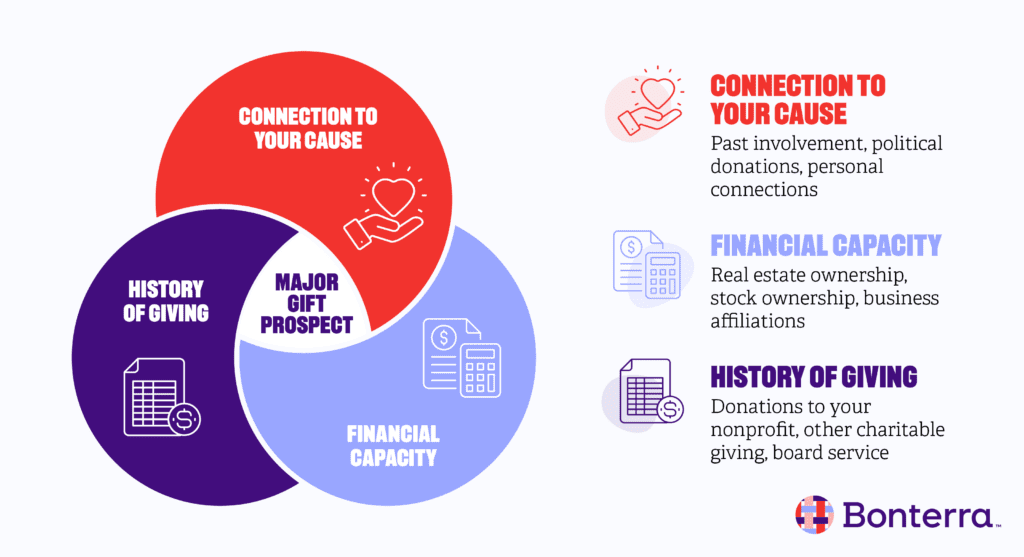
- A connection to your cause. Every prospect should have a clear connection to your cause, whether they’ve supported your nonprofit in the past or know multiple board members. Look for data about an individual’s past involvement with your nonprofit, relevant political donations, and personal connections to others affiliated with your organization to determine their affinity to give.
- The financial capacity to donate at your nonprofit’s major giving level. Assess prospects’ financial resources by analyzing wealth indicators like real estate ownership, stock ownership, and business affiliations. Use verified data to estimate whether they truly have the means to give at or above your major gift threshold.
- An established history of giving. Major giving prospects must be philanthropically inclined to consider making a substantial gift. Research their donations to your nonprofit, other charitable giving activities, and any board service to ensure they have a habit of supporting organizations like yours.
When you find someone with all three characteristics, add them to your prospect list. From there, conduct further research to validate your data and start prioritizing prospects based on who is most likely to contribute a major gift.
4. Design a major gifts cultivation plan.
Once you’ve identified prospects, you’ll need a solid plan for cultivating relationships before you make your ask. Create a general cultivation plan that incorporates a variety of major donor cultivation best practices while leaving room for personalization.
This plan should include:
- Face-to-face meetings with the prospect to discuss your nonprofit and their interests.
- Invitations to exclusive events, such as VIP dinners, tours of your organization’s facilities, etc.
- Regular emails and phone calls to check in with the prospect and evaluate their level of interest in giving.
- Interactions with key stakeholders like board members, existing major donors, or nonprofit leadership.
- An adaptable timeline for major donor cultivation based on individuals’ progress.
All of these activities help your organization start building relationships with prospects, which will motivate supporters to eventually donate major gifts.
Use prospect research data and notes from every interaction with prospects to tailor these plans to each individual’s needs and interests. This way, they’ll see that you value their individual support, and you’ll be able to make more informed choices when it comes to cultivation and solicitation.
5. Draft a major gift fundraising ask.
After you’ve done the hard work of cultivating a relationship with a major donor prospect, it’s time to transition to the solicitation phase.
When it comes to an ask of this magnitude, it’s essential to highly personalize the appeal and use data to ask for a major gift the prospect would be willing and able to give. Most major donors want to know exactly how their contributions will be used, so suggest a few areas they could donate to while encouraging them to give to the program or project that needs their funding most.
As you choose the ask amount and which project you’ll invite them to support, consider their:
- Charitable interests.
- Business affiliations.
- Ties to your organization.
- Giving history.
- Current giving inclinations.
- Projects and campaigns they seem excited about.
In most cases, you’ll solicit major gifts during an in-person or virtual meeting. Occasionally you can get a donor to commit through a written major gift proposal, but having a conversation allows the prospect to ask questions and helps you work together to find a solution that benefits everyone involved.
Even for just a meeting, writing out your solicitation in proposal format helps you get your thoughts on paper and makes the ask go more smoothly. Plus, it can serve as a leave-behind for the donor’s reference. If you don’t write a full letter, at least jot down some talking points or a brief conversation outline to prepare.
Be prepared to adapt your presentation based on their reaction. Engage the prospect in a true dialogue, and let their responses guide the conversation. If they say no or aren’t ready to commit to giving just yet, be ready to thank them for their time and suggest alternatives.
6. Plan several stewardship strategies.
Donor stewardship is the process of engaging and retaining donors after they make a gift. While this should always involve thanking donors, your stewardship efforts should also include a range of additional activities designed to keep your new major donor informed and involved.
As with any donor, you should choose stewardship strategies that align with the donor’s giving level and personal preferences. For major donors, appropriate stewardship ideas include:
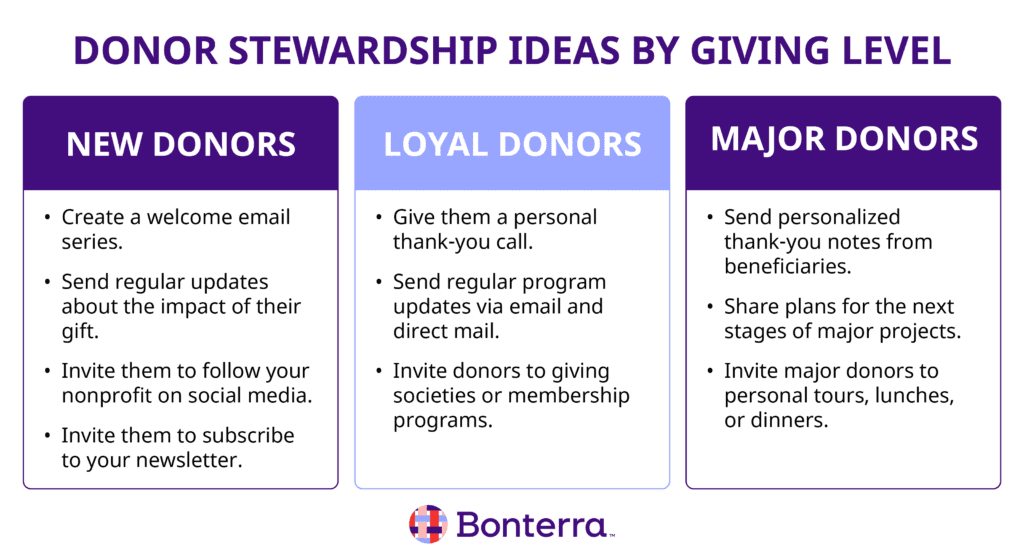
- Sending personalized letters and thank-you notes. These might come from your major gifts officer, executive director, or even beneficiaries themselves.
- Sharing insight into your nonprofit’s plans for upcoming projects, the next stages of major campaigns, and other strategic efforts.
- Inviting them to get more involved. Depending on their interests, you might invite major donors to personal tours, lunches, dinners, or VIP appreciation events.
In each activity, focus on regularly acknowledging the impact your major donors make on your organization and purpose. However you choose to steward your donors, put your major donor solicitation strategies and goals into a clear, customizable plan for future reference.
Expert tips for soliciting major gifts
Improve your nonprofit’s major gift strategy and solicitation success rate by following a few expert best practices.
Seek multiple types of major gifts.
In action, major gifts are incredibly varied and can take a wide range of forms. Beyond your standard cash donation, stay open to other common types of major gifts, like:
- Stocks. Publicly traded stocks, mutual funds, bonds, and privately held stocks can all be gifted to nonprofits. When donating stocks, donors don’t pay capital gains tax and can also receive an income tax deduction for the shares’ current value.
- Real estate. Donations of land and property holdings tend to be some of the largest gifts to nonprofits. As with stock donations, donors won’t pay capital gains tax on appreciated real estate and can receive an income tax deduction on the current value.
- Cryptocurrency. Many of your wealthiest potential donors own cryptocurrency, making it likely that they might want to donate in this form and receive additional tax benefits.
- Qualified charitable distributions (QCDs). QCDs are tax-free gifts made from an individual retirement account (IRA). For older, wealthy donors, this type of major gift decreases their income tax and counts toward the amount they’re required to withdraw from their IRA each year after turning 72.
- Donor-advised fund (DAF) grants. Many donors have private funds for charitable giving that are administered by a third party. Donors receive immediate tax deductions when they add to the fund, and they can donate the investment revenue at any time.
Major donors often have varied financial situations and preferences, so it’s important to accept all of these types of gifts. Giving donors options makes it more likely that they will find a suitable option and ultimately make a major gift.
Invest in the right fundraising tools.
The fundraising software you use to identify major donor prospects, record data from your interactions, and determine the best ask amounts can make a major difference in your success. Major gift fundraising relies on having comprehensive, accurate data about prospects, so you need a solution that can house and analyze that data effectively.
Evaluate your current fundraising tools and determine if you need to invest in a more scalable solution. Ideally, your fundraising and donor management software should include:
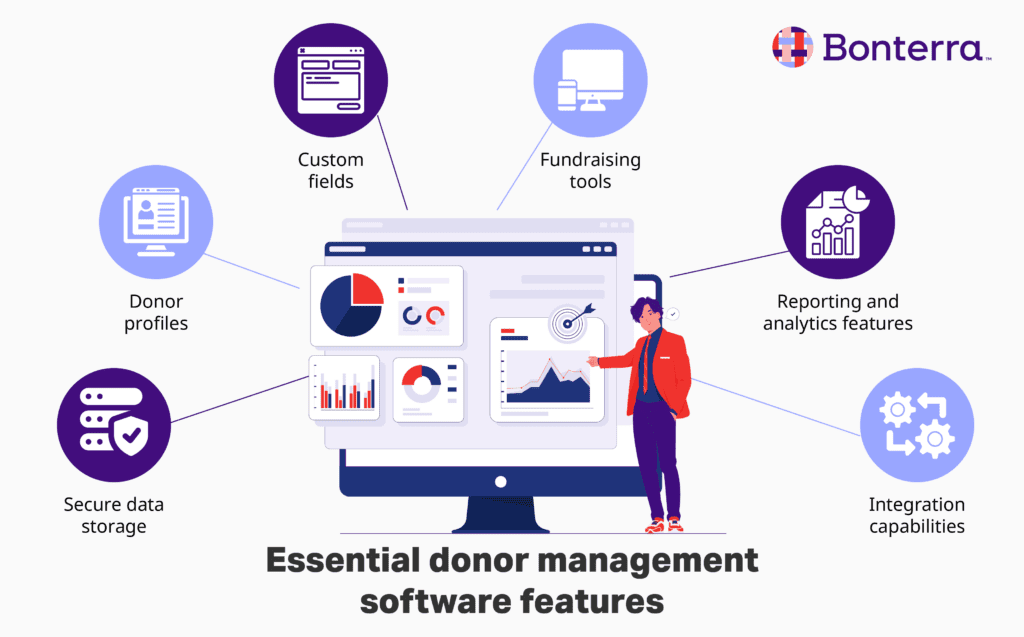
- Secure data storage.
- Comprehensive donor profiles.
- Custom fields.
- Fundraising automation tools.
- Reporting and analytics features.
- Integration capabilities.
If you use third-party prospect research tools or databases, it’s particularly important that your fundraising software integrates with these tools. You should be able to automatically add prospect research data to prospects’ donor profiles and update it as you learn more. This will help your team streamline donor research and determine the best cultivation strategies for each prospect.
Looking for a robust solution that meets all your major gift fundraising needs? Demo Bonterra Fundraising and Engagement (built on EveryAction) today.
Incorporate major gifts into all your fundraisers.
While your major gifts program is essential to your nonprofit’s fundraising success, it should be just one part of your fundraising strategy. Pair major gift fundraising with other important types of giving, such as:
- Annual giving. The best major gift prospects often already give to your organization each year. As a result, it’s critical to dedicate time to your annual fundraising program and build existing relationships with recurring donors.
- Capital campaigns. Fundraising for significant investments such as new construction, new programs, or building an endowment often relies on major gifts. For successful campaigns, your major gifts strategy must work alongside your capital campaign strategy.
- Planned giving. Planned giving is the allocation of gifts donors will give in the future, often through wills, bequests, or trusts. Major gift fundraising and planned giving are very similar, so organizations often combine the roles of managing the two into one position.
How your nonprofit integrates these types of giving will depend on your current situation. In any case, your nonprofit should leverage some combination of major donor fundraising, capital campaigns, planned gift cultivation, and establishing an annual giving program to create a sustainable fundraising strategy.
Start refining your major gifts strategy today
Ultimately, major gifts make a significant difference in your organization’s ability to further its purpose. However, because of these donations’ size, it’s important that you take the time, invest in the tools, and dedicate the resources to implement a detailed strategy for navigating major donor relationships.
Earn more major gifts with comprehensive, secure fundraising software.
Work with Bonterra


